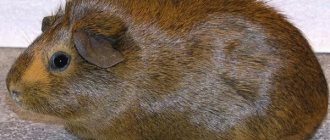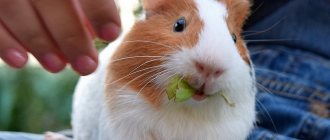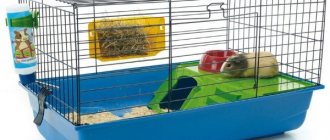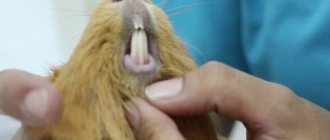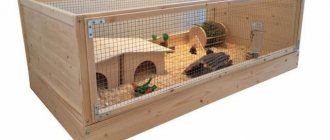The guinea pig has nothing to do with the sea; it doesn’t even really know how to swim. At first it was called overseas, but over time the name was replaced by a more modern one. Comes from South America. In our area, it can be considered an almost ideal pet. He is not capricious, requires minimal attention, eats little. Before purchasing a guinea pig, it is important to find out the price in your area. It can vary several times.
The cost of a guinea pig depends on the following factors:
- Breed;
- Age;
- Appearance and condition;
- Place of purchase, from hand or in a pet store;
- Region.
You can buy a guinea pig at most pet stores. Due to its small size, it does not interfere at all at home. The price of a pig in pet stores is 100–7000 rubles. But you can find it for free, just search the Internet on free classifieds sites. Often someone wants to give animals into good hands, but does not ask for anything in return.
How much does a guinea pig cost?
| Data left by users (City, cost) | |
| Prokopyevsk | 700rub |
| Yegoryevsk | 2000 |
| Bor | 1000 |
| Krasnoslobodsk | 300 |
| Korosten | 989 |
Guinea pig was once called overseas, and only over time its name changed. So the sea has absolutely nothing to do with it; this animal has nothing to do with the sea. And the name overseas does not suit it well, since it is from South America, rather overseas.
Many zoologists classify guinea pigs as a special species of rodents, the development of which has been going on for 40 million years. Around the ninth millennium BC, the Incas domesticated the guinea pig. It is worth noting that these animals were brought to Europe by the Spanish conquistadors 400 years ago.
This is interesting! The ancient ancestors of guinea pigs were the size of an ox and weighed up to 700 kilograms.
The cost of this cute pet depends on some nuances:
The guinea pig is very popular among pet lovers because it is unpretentious, small in size, and can be bought at any pet store. If you don’t want to buy an animal for money, then you can look for ads online, where they often offer guinea pigs for free. In a pet store you can buy a pet for a price from 1,000 rubles to 5,000 rubles .
Other expenses
- Cage (60x40) approximately 1,000 - 2,000 rubles
- Nipple drinker | 150 rub.
- plastic feeder - 100 rubles (not convenient - pigs often turn it over), ceramic - 450 rubles
- Sawdust (1 kg) | 50 - 200 rub.
- Hay (1 kg) | 150 - 300 rub.
Benefits of owning a guinea pig
- Not aggressive, doesn't bite
- Unpretentious
- Does not have an unpleasant odor
- Don't need a big house
- She quickly becomes tame and loves affection.
In addition to all these advantages, the guinea pig reproduces easily, and breeding work is simple and entertaining. To date, more than 50 breeds of guinea pigs have been bred. The guinea pig is so popular that seminars are held on its breeding, exhibitions are organized, and there are specialized specialized publications.
Guinea pigs become adults and capable of breeding within a month after birth.
But of course, for the majority, a guinea pig is just a sweet, affectionate friend who does not require special attention and care.
Memo to the beginning pig breeder
So, at your first superficial acquaintance with guinea pigs, you had the most favorable impression of these animals, you found them charming and decided that such a pet was quite suitable for you.
Before the long-awaited purchase is made, we suggest once again weighing all the pros and cons. From the moment new residents appear in your home, you have a number of obligations to them.
IMPORTANT! From now on, you devote a significant part of your time and money to two more members of your family (guinea pigs).
* Based on the results of a survey of members of the group “Guinea Pigs!” on a social network, from 300 to 3500 rubles are spent on maintaining 2 guinea pigs per month. This difference in expenses is due to the place of residence of the owners, their commitment to more expensive/cheaper products, as well as the fact that some guinea pig owners, when calculating expenses, did not take into account the cost of succulent food (vegetables, fruits, herbs) and had the opportunity not to spend money on hay and litter (own farm, rural areas).
* according to my personal calculations: 100 rubles per day are spent on one guinea pig (subject to feeding purchased vegetables and herbs).
Calculate your upcoming expenses (after all, you will now have to pay every day):
One-time expenses: – a cage of at least 70 cm in size for two pigs, and a larger one for pigs of more than two (can be purchased at pet stores, or found for free on bulletin boards such as Avito); – drinking bowl; – several feeders; – same-sex or opposite-sex pair of guinea pigs
Additional expenses: – purchase of panels and other materials for the enclosure. – absorbent baby diapers for walking around the room.
Monthly expenses: – sawdust, which needs to be changed in the cage approximately once every 3-4 days (depending on the size of the cage); – hay, which pigs should have 24 hours a day, 365 days a year; – granulated food; – greens, vegetables, lettuce and other food products for guinea pigs, in the amount of at least 200 g per 1 pig per day.
Unforeseen expenses: – purchase of medications, delivery to the veterinarian, payment for doctor’s services (expensive!)*.
* Make sure that in your city there is a specialist in rodents and lagomorphs - a rodentologist. A visit to an ordinary veterinarian who knows nothing about the treatment and characteristics of pigs can be disastrous for the rodent. Keeping a guinea pig as a pet has a number of advantages, however, you may also encounter a number of difficulties, including illness of the animal. Treating pigs is expensive! Are you ready for this kind of spending on a rodent?
Small “buts”:
- Guinea pigs are not aggressive (however, biting specimens are sometimes found among guinea pigs), but this does not mean that the animal will immediately behave friendly and trusting. By nature they are very shy, and for a long time the animal may be wary of you.
- A guinea pig quickly learns to recognize its owner, many animals quickly get used to it and subsequently respond to their name or to some sound, but you should not expect intelligence and obedience from a guinea pig, active “play” with a child, much less perform any tasks. commands Guinea pigs are not endowed with the intelligence of a dog or cat and in many ways their behavior is quite primitive.
- Guinea pigs are practically impossible to train and get used to going to the toilet throughout the entire space of the cage (enclosure, room), and not in the place strictly designated for this by the owner. Therefore, it is necessary to regularly (at least once a week, but preferably twice) change the bedding in the cage to avoid illness of the animal and a strong smell in the room.
- Many guinea pigs are very active, especially during childhood. In this regard, be prepared for sawdust, hay and droppings to be constantly scattered around the cage in which your pets live. The exception is the so-called dune cages with plastic walls instead of bars, but they have a number of disadvantages: first of all, for the animal itself, as well as for the owner, who will not be able to secure something in it without making additional efforts and ingenuity.
- The daily routine of a guinea pig, as a rule, coincides with that of a human, that is, it sleeps at night and is awake during the day. But it is possible that some animals will want to stay awake at night. In addition, early in the morning or at night, your pig may drink noisily from a hanging drinker. Therefore, if you are very susceptible to various types of noise, you should consider locating the cage away from family recreation areas.
- Guinea pigs are very talkative. Sometimes they behave too noisy and intrusive, demanding your attention or begging for a treat.
- Guinea pigs also develop better and feel better if they have the opportunity to run freely around the room at least once a day (if the pigs spend all their time in a cage, then the walking time should be at least 6 hours a day). It is necessary to remember:
- that pigs are rodents and can slightly chew furniture and wires near their walking area;
- can climb into places that are difficult for humans to reach;
- can stain carpets or floors with “products of their vital activity”;
- may get sick if there is a source of cold air or draft nearby.
IMPORTANT! Some of your pets' behavior may frustrate you.
Before 2 new residents appear in your home, make sure that they are provided with everything necessary for life. Prepare for this:
- A spacious cage or enclosure (for the normal functioning of two pigs you need to purchase a housing of at least 120x60cm);
- Carrying;
- drinking bowl;
- Bowls;
- Hay;
- Granular feed based on hay and grass;
- Filler - sawdust;
- Claw cutter;
- Checkered accessories (hammock, pipe, shelf, etc.)
IMPORTANT! Before buying guinea pigs, prepare everything in advance: the animals must arrive in a fully equipped home. Who should I buy?
- You can't have just one animal. Guinea pigs are very sensitive to lack of communication and feel bad when alone. If you are able to provide proper care for one animal, then buying two animals at once will not hinder you in any way, but you will provide the necessary minimum of life for your animals and get unexpectedly great pleasure from watching their life together. If you are not ready to take two same-sex pigs at once, then you should not get one, dooming a social animal to loneliness.
- Buy animals of the same sex. In this way, you will provide your animals with good company and eliminate the possibility of unexpected offspring. Childbirth in pigs is difficult, and the female and/or offspring often die.
- It is worth mentioning that incivility and outbreaks of sudden aggression can often arise both among males and in an exclusively female group. At the same time, by creating optimal conditions for keeping your pets, you reduce this risk to almost zero.
- Guinea pigs have very varied personalities, so each situation is very individual. The only advice that can be given is: try to introduce animals from a very young age (but do not buy pigs under 1 month old!) or place a piglet 1-3 months old with an older pig. In this case, they will have more chances to get along with each other.
IMPORTANT! Guinea pigs do not tolerate loneliness well. Get a couple of same-sex animals.
VERY IMPORTANT! It is worth noting that you must be absolutely sure that neither you nor anyone in your household is allergic to grass, hay, epithelium or secretions of guinea pigs. Even if you buy hairless guinea pigs (Skinny and Baldwin breeds), this will not protect against allergies.
This can be checked by donating blood from a vein to a medical laboratory to determine specific IgG to guinea pig allergens. You should not purchase an animal without testing if you are already allergic to another type of animal.
A pig breeder always needs to REMEMBER that a pig is a small, defenseless living creature, for whose life and fate the owner is directly responsible!
If you realize this, then you are that long-awaited owner - the dream of any guinea pig.
(link to the site of the source of the material https://msvinkadoma.wordpress.com)
How to keep a guinea pig?
The guinea pig is easy to keep - it does not need a large enclosure or terrarium, it is silent, and is not fussy about food. You just need to follow some recommendations for the comfort of your pet:
- The cage should have a high tray, 15 cm. This will not only protect the pet from drafts, but also the apartment from debris.
- A hay box is required, which will be suspended from the top of the cage.
- Ball water bowl for rodents and hamsters. It is better not to put a cup of water, as the pig will simply turn it over and the cage will be damp.
- The wheel in the pig's cage is unnecessary.
- The litter needs to be changed frequently.
- Once you have fed your pig, the feeder should be removed.
- There should always be wood or chalk in the cage. The pig must constantly grind its teeth.
Important! Guinea pigs are forced to eat constantly and in small portions due to the special structure of the digestive system. The main food of these animals is hay.
Guinea pigs sleep for 10 minutes several times a day, the rest of the time they are awake.
Arrangement of the cage
What size cage is optimal for kevi? Pigs are active, so they need at least 0.7 m2 of space for normal functioning. A cage without a ceiling is allowed if its walls are higher than 35 cm. The floor of the cage must be solid and not lattice, otherwise the animal may damage its paws. You should not put a kevi in a huge cage with several floors: the animal can fall from a high floor and damage its limbs. A paper bedding is laid out on the floor, which needs to be changed weekly.
You should definitely buy a house for your animal where you can hide and sleep. You need to put a feeder and a water bowl in the cage. It is also recommended to equip the cage with tunnels from which the animal will crawl out, swings and other interesting toys.
At what age should you buy a guinea pig?
The best option would be to buy a very young guinea pig so that the animal grows up before your eyes - it’s very exciting. You can feed all vegetables, fruits, grass and hay. Guinea pigs eat salads, dandelions and cabbage well, but this feeding must be given carefully and little by little. It’s good if your guinea pig’s diet includes twig food. There should be hay in the cage all year round. If we talk about roughage, you can buy special food for rodents and guinea pigs in the store, or you can give them simple grains of wheat or oats. Vitamins and minerals should be included in the diet periodically, especially in the off-season and winter. In cold weather it is necessary to add vitamin C to the feed.
Guinea pigs usually live for about 5 years, but with good care their life can be extended for several more years.
Conditions of detention
Cavie likes to be the center of attention, so the cage should be placed in the area of the house where the owners are most often. A pig cannot live alone; it must be in contact with a relative. It is strictly forbidden to keep an animal in the yard or garage. On the street, the animal will catch a cold, and in the garage it can be poisoned by volatile chemicals and die.
The cage should be periodically placed on the windowsill or, in the warm season of the year, taken out to the balcony so that the pet can sunbathe. To prevent the cage from falling from the windowsill, it must be securely fixed.
Angora guinea pig - how much does it cost?
The breed is common, so you can buy an Angora guinea pig quite cheaply. On average, this breed costs from 1,500 rubles to 3,000 rubles . This variation in price depends on where you purchase it. If the owner of the pig is selling, then buy for the first figure, but in a specialized store it will most likely cost 3,000 rubles, but not more.
The price will also be affected by the age of the guinea pig and its type. This is a very cute animal as it has long and attractive fur. A variety of the Angora guinea pig is the rosette guinea pig, which costs the same as the Angora.
Nail care
Claw care is extremely important. If the claws are not trimmed, they grow so long that the paws become deformed. The procedure is carried out twice a year for animals that have reached one year of age. For the procedure you need:
- nail clippers;
- towel;
- hemostatic powder.
The pig is taken out of the cage and placed on a towel spread on his lap. Then you need to wait a little for the animal to come to its senses and calm down. When the pet relaxes and feels safe on its owner’s lap, you can begin to slowly and calmly cut off the claws from its paws. If a blood vessel is accidentally damaged during the procedure, a hemostatic powder is applied to the wound.
Hairless guinea pig – price
But this is a rare breed - the skinny, or hairless guinea pig. This breed has a gene that is responsible for complete baldness by the age of one month. Since this breed is very rare, its price is correspondingly high. But besides rarity, the price will depend on the place where you buy it. But be that as it may, its cost will not vary much and will be 3,000 - 4,000 rubles.
But before buying this breed of pig, contact the seller for recommendations on keeping it, since it does not have wool and is very sensitive to the environment.
Video
Source
Dental care
The natural number of teeth a pig has is 20. The lower teeth are 1.5 times longer than the upper ones. The upper jaw protrudes slightly above the lower jaw. The incisors do not fit tightly to each other and have an arched shape. Rodents' incisors grow continuously, so animals have to grind them down with solid food. The kevi menu should include grain feed, tree branches and other solid foods. If a pig eats only soft food, then its teeth grow so long that they injure the gums, lips, and tongue.
To shorten a pet's overgrown incisors, the owner needs to contact a veterinary clinic. If your pig has an abnormal bite, you will have to take it to the vet every three months. Malocclusion can be congenital, or acquired as a result of a jaw injury, an infectious disease, or poor nutrition.
Why do guinea pigs' teeth break? This kind of trouble occurs due to a fall, a blow to the face, a poor diet, or a deficiency of vitamins C and D in the body. In rare cases, fragility of teeth in animals is caused by genetic pathologies or dysfunction of the thyroid gland. There is no need to worry: a broken tooth will grow back in about two weeks. But the rodent should be taken to a veterinary clinic so that the doctor can smooth out the sharp tip of the injured tooth.
What does the price depend on?
Prices for rodents can be very varied from 300 to 15 thousand rubles . The cost of an animal depends on many factors.
What does the price consist of:
- Animal breed.
- Purity of coat color.
- Quality, length of wool, number of rosettes.
- Availability of pedigree.
- Pet's age.
- Gender. Females are often more expensive than males.
- For breeding or “for the cushion”. Even babies from the same litter can vary greatly in price. Some pets are suitable for breeding, others are not. Unsuitable individuals live well as pets and are much cheaper.
- The presence or absence of defects in color or coat.
- Place of purchase. Nursery, market or from hands.
- The final cost may depend on the location of the nursery. The cost of transporting animals from city to city usually falls on the buyer.
If you need a pet, then you can ignore pedigrees, color purity and other parameters. The main thing is that the pig is healthy and has a pleasant character.
For breeding, it is necessary to purchase purebred producers. In search of such rodents, it is best to contact breeders in nurseries. Pets will cost significantly more, but the risk of buying the wrong animal will be lower.
Coat care
You need to accustom your pet to grooming from a young age. At the pet store you should purchase:
- soft brush;
- wide-toothed comb;
- metal comb;
- small scissors.
Short-haired pigs know how to care for their coat without human help; they straighten and clean their coat with their teeth. The owner only needs to brush his pet twice a week with a soft brush to remove faded hairs.
Long-haired pigs have hair that gets matted all the time. Therefore, combing is carried out daily. If tangles have formed, they are carefully cut off with scissors. During lactation, females are advised to carefully cut off the fur around the nipples so that the babies can get to the milk. We also cannot help but talk about the amazing behavior of long-haired pigs. Animals act as hairdressers for themselves and their relatives: they independently cut out excess hair with their teeth. What causes this phenomenon has not yet been established.
How much does a guinea pig cost?
Breeders are constantly developing new and unusual varieties. More than 80 subspecies can be found on sale. It is difficult for a beginner to immediately determine which breed is the most beautiful and interesting. If you plan to have a purebred rodent, then you need to be prepared for the fact that their prices are quite high.
Breeds and prices in rubles:
- American 300–2500.
- Self 2000–4000.
- Abyssinian (rosette) 300–1500.
- Peruvian 800–5000.
- Alpaca 1000–6000.
- Sheltie 1500–6000.
- Coronet 2000–5000.
- Texel 5000–8000.
- Merino 2500–7000.
- Agouti 1000–2500.
- Roans 2000–3000.
- American Teddy 1500–6000.
- Rex (royal guinea pig) 300–3000.
- Ridgeback 1000–2500.
- Crested 500–3000.
- Satin 3000–5000.
- Himalayan 2000–7500.
- Kui 800–4000.
- Skinny 5000–10000.
- Baldwin 4000–8000.
If you are going to breed, don't skimp. When buying a pet in a store or market, you risk taking a cross that will not live up to your expectations. The most unusual children can be born from crossbreeds.
Very often you can find advertisements online where animals are given away for free or at a low price. If you don't need pedigrees, call the sellers. But be careful, as they usually give away old, sick or tired pets for free.
Attention! It is better to purchase young pigs from breeders. If you are concerned about the cost of purebred animals, check with the seller to see if the nursery has rodents that are not suitable for breeding.
When purchasing, you should pay attention to the conditions of maintenance and appearance. You should not buy a rodent simply based on a photograph. Do not hesitate to carefully inspect the animal you want to adopt. A healthy animal is active, with clean, shiny fur. Avoid fearful, sick or aggressive animals.
Owner reviews
Naturally, high-end guinea pigs are inaccessible to ordinary buyers. In any case, if you plan to breed them, you should opt for purebred specimens.
Interesting to know! In our country, guinea pig breeding has not yet reached such a high level as abroad. Despite this, true connoisseurs of these animals try to acquire individuals that have an attractive and exotic appearance.
It should also be remembered that you cannot cross long-haired and short-haired representatives of the breeds, since the result will be offspring that are low-quality mestizos and no one will allow them to be shown at exhibitions. On top of that, crossing different breeds is also unacceptable because it hinders the improvement of the breed data of any of the species.
Guinea pigs have earned the right to be considered one of the most sought-after pets. Ease of care and maintenance is acceptable for everyone, even novice owners. This is an affectionate and sociable animal that is perfect for families with children.
Care and maintenance of guinea pigs
To keep your pet you will need a cage or enclosure. Guinea pigs are large, active animals, so the living space should be quite spacious.
Optional equipment:
- Nipple drinker. Such models prevent water from getting onto the bedding or pet.
- Ceramic or clay feeder. The plastic is too light, the animals will constantly turn the bowl over and spill the food.
- A large house made of wood or thick plastic.
- Hammocks, tunnels.
- Metal sennik.
For bedding, you can use large shavings or wood pellets. Breeders recommend adding a layer of sawdust on top of the granular filler. The soft bedding prevents injury to your pet's fingers and toes.
Eye care
A healthy pig's eyes are fine: there is no inflammation, liquid or purulent discharge. The sore eye looks swollen, the cornea turns red, and mucus or pus appears. If such symptoms occur, you should urgently take your pet to the veterinarian.
Below is a list of eye pathologies that guinea pigs are prone to:
- microphthalmos;
- blepharitis;
- conjunctivitis;
- dermoid cyst of the eye;
- exophthalmos;
- corneal clouding.
